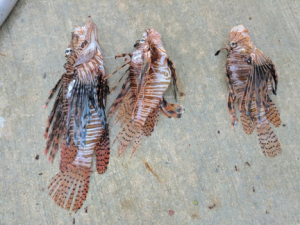Invasive, Toxic Lionfish: When Predator Turns Prey
by Stone Washington
The voracious lionfish met their match when consumed by the insatiable appetite of Hurricane Irma. During the destructive September 2017 category 4 storm that ravaged much of the United States’ eastern coast, the Florida Keys became the center of immense devastation. As the hurricane barreled up the east coast, Irma’s destructive impact left hundreds of sunken boats in the Gulf of Mexico, creating significant oil and sewage spills.
The storm affected many sea creatures by exposing them to  released fuel. One creature in particular, the lionfish, has become a central interest to Dr. Peter van den Hurk in the Department of Biological Sciences. He mentors the Ecotoxicological Effects in Aquatic Species: Lionfish as Indicators for Oil Pollution in the Caribbean Creative Inquiry project. The team is examining whether lionfish are adversely affected by oil contamination. “The lionfish are voracious feeders and they grow fast. They eat an enormous amount of small fish,” van den Hurk explains. This voracious appetite contributes to the bioaccumulation of toxins or pollutants from the oil spill—as lionfish eat, they accumulate the toxins that are in their prey. Since lionfish are an invasive species and are negatively impacting native fish species, there are no restrictions on catching them.
released fuel. One creature in particular, the lionfish, has become a central interest to Dr. Peter van den Hurk in the Department of Biological Sciences. He mentors the Ecotoxicological Effects in Aquatic Species: Lionfish as Indicators for Oil Pollution in the Caribbean Creative Inquiry project. The team is examining whether lionfish are adversely affected by oil contamination. “The lionfish are voracious feeders and they grow fast. They eat an enormous amount of small fish,” van den Hurk explains. This voracious appetite contributes to the bioaccumulation of toxins or pollutants from the oil spill—as lionfish eat, they accumulate the toxins that are in their prey. Since lionfish are an invasive species and are negatively impacting native fish species, there are no restrictions on catching them.
The primary goal for this project is to determine if lionfish can be a monitoring species for assessing the effects of oil on marine life. Students are closely examining lionfish exposed to oil contamination and conducting biochemical analyses to see if ingested oil compounds are impacting protein and enzyme activity. The team hopes their work will serve as the baseline for assessing the health of marine organisms after an oil spill by measuring their toxicological response.
“That’s the whole point of this Creative Inquiry project,” van den Hurk states, “is to find out when the lionfish are exposed to oil compounds, what is their response? What can we measure in the fish as a response to the oil compound?”
To completely understand the toxicological response seen in lionfish collected post spill, the team needed to conduct more controlled experiments. To do so, they collaborated with the National Oceanic and Atmospheric Association (NOAA) Ecotoxicology Branch in Charleston, SC. They used the NOAA facilities to conduct a controlled exposure experiment in which an experimental group of lionfish were exposed to three different concentrations of oil extracts. After the trials, the team extracted the liver and gallbladder from each fish and returned to Clemson to conduct a biochemical analysis. The results from this analysis will shed light on the previous lab results obtained from lionfish collected in the Florida Keys.
 The project is largely student-driven, allowing for students to freely experiment while van den Hurk is available to answer questions. Shelly McComb, a senior biological sciences major, enjoys her role in monitoring captured lionfish. “Lionfish could be an indicator that the entire coral reef system and all of the fish are being harmed and polluted. It could have a big impact, or we could find that nothing is happening and that lionfish are really resilient, which is why they are taking over,” McComb says.
The project is largely student-driven, allowing for students to freely experiment while van den Hurk is available to answer questions. Shelly McComb, a senior biological sciences major, enjoys her role in monitoring captured lionfish. “Lionfish could be an indicator that the entire coral reef system and all of the fish are being harmed and polluted. It could have a big impact, or we could find that nothing is happening and that lionfish are really resilient, which is why they are taking over,” McComb says.


